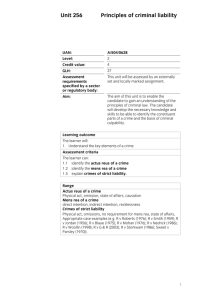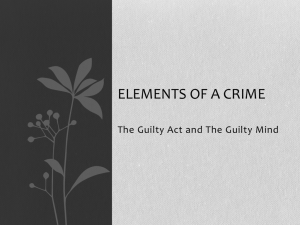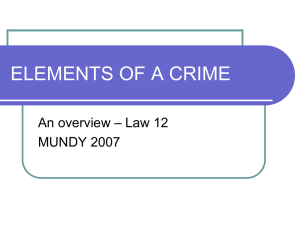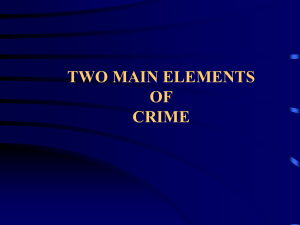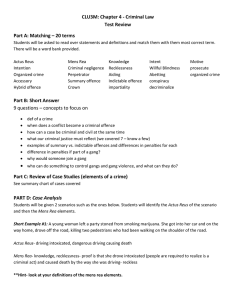Actus Reus and Mens Rea
advertisement
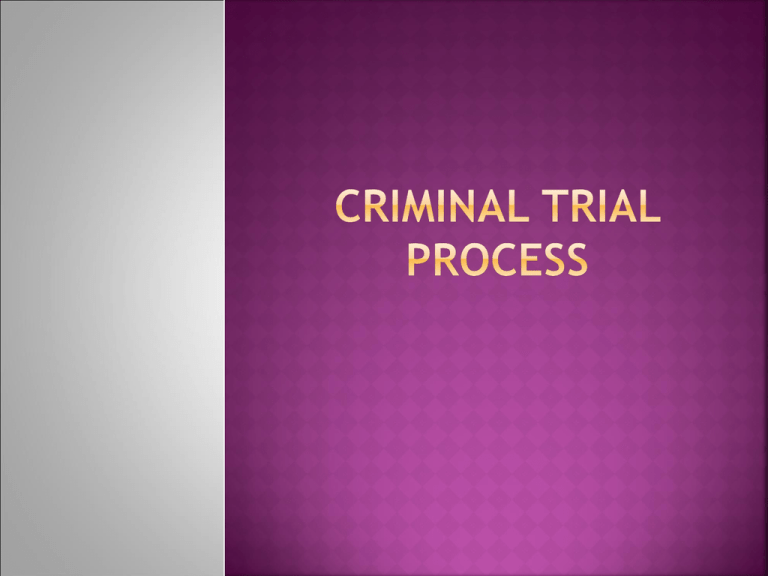
Trial procedures in Canada are based on the ADVERSARIAL SYSTEM – two opposing sidesthe Crown and Defence. There are many key players in a trial: Judge- Appointed by the Fed government 1. Have complete control of courtroom May determine guilt/innocence if there is no jury Sentences the offender Crown/Prosecutor- Represents the state (and society) 2. Has the BURDEN OF PROOF- Onus is on the crown to prove that the accused is guilty BEYOND A REASONABLE DOUBT Prosecutors must disclose all available evidence whether they plan to introduce it or not, even if it may weaken their case- principle of disclosure. Defence- Represents the accused 3. Ensures that the accused’s legal rights are protected and that a proper legal defence is provided (if possible) Plant seeds of doubt in the minds of the judge or jury so the accused can not get convicted. Court Clerk and Court Recorder 4. Court Clerk- reads out the charge against the accused, swears in the witness, handles evidence and paperwork. Court Recorder- records word for word all evidence given and all questions and comments made during trialaccurate records are VERY important for the Sheriff 5. A Crown-appointed official who acts as part of the justice system- serves summons, carries out court orders Other Court officials 6. Probation officers Representatives from non-profit organizations To obtain a conviction the Crown must prove beyond a reasonable doubt that EACH and EVERY element of the offence with which the accused is charged was in fact committed by the accused. CULPABILITY- guilt; blameworthiness Actus Reus CRIME Mens Rea Latin for a “guilty act” Physical Component The act or omission (failure to act) that has been identified by Parliament as sufficiently harmful to warrant state intervention It is usually very easy to determine the Actus Reus of a crime by reading the CCC EX.- s.222 (1) “A person commits homicide when, directly or indirectly, by any means, he causes the death of a human being.” What is the Actus Reus of Homicide? Causing the death of a human being. The actus reus of an offence is not always so easy to determine EX- S. 90 (1)- “Every person who commits an offences who carries a weapon...concealed, unless the person is authorized under the Firearms Act to do so.” Is there any trouble with determining the Actus Reus of this crime? What defines a weapon? Is having something in the trunk of your car a concealment? This is where it is necessary for the judges to interpret the law and apply precedents. Actus Reus must be committed voluntarily-it must be the conscious choice of an operating mind. People are not held criminally responsible for actions they cannot control. “Actus non facit reum nisi mens sit rea” The act will not make a person guilty unless the mind is also guilty. Latin for “guilty mind” Mental component Moral guilt A person must be found to have had the necessary “state of mind” or mens rea for the offence before they can be found guilty. It is irrelevant whether or not the person knew the act was illegal. Ignorance of the law is not an excuse. EX- S. 319 (2) it is an offence to wilfully promote hatred. What is the mens rea in this offence? What a reasonable person would have understood, perceived or foreseen in a circumstance Less concerned with the actual knowledge of the accused Accused state of mind at the time of the commission (court tries to determine what the accused was thinking at the time of the offence) Only actual intention or knowledge of effects are relevant Requisite intention The Mens Rea that the Crown is required to establish in order to convict an accused of an offence (the person intended to commit the crime) DIRECT INTENT- 1. Where a person commits intentionally a forbidden act with the knowledge of all the wrongful circumstances which statute seeks to prohibit RECKLESSNESS 2. Accused may not intend the consequences of their actions If they understand the real risk of the consequences they will be deemed to have intent (a reasonable person ought to know) EXAMPLE- Assume that you require prescription glasses to operate a car. You have misplaced your glasses but you decide to drive without glasses. As a result you cannot see and you veer into oncoming traffic and cause a major accident. *** You had the necessary intent to commit a crime because you behaved recklessly. – Dangerous operation of a motor vehicle. WILFUL BLINDNESS 3. Accused has suspicion of the consequences of action and fails to inquire because they do not want to know the answer, they will be deemed to have intent (to suspect and not question) Example Amanda and Keisha are walking down the street when they come across some DVD stalls. Keisha notices the DVDs are a lot of cheaper than in the store. She wonders if they might be illegal copies. She decides that she’d rather not know either way. She buys two DVDs for $8. REMEMBER the accused may not intend the consequences of their actions If they understand the real risk of the consequences of their actions they will be deemed to have intent-recklessness If the accused has suspicions of the consequences of actions and fails to inquire because they do not want to know the answer, they will also be deemed to have intent- willful blindness OVERALL INTENT HAS MORE TO DO WITH KNOWLEDGE OF CONSEQUENCE AND CIRCUMSTANCE NOT MOTIVE! MENS REA OFFENCES 1. The Crown must prove Actus Reus and the direct intent beyond a reasonable doubt to convict. This category is for serious crimes that have a sentence of 10 years or more. STRICT LIABILITY OFFENCES 2. The Crown must prove Actus Reus and subjective intent beyond a reasonable doubt to convict. The accused has an opportunity to prove DUE DILIGENCE (the accused did everything possible to prevent the crime from occurring). EXAMPLE: Local residents of a small Ontario town have been complaining about a strange smell coming from a nearby stream. When environmental officials come to investigate, they notice a spill between the stream and a large aluminum factory. They trace the spill to a defective pipe belonging to the factory that is used to transport waste from the factory to the sewage plant. Even though factory officials claim they did not know about the spill, the company is charged with an offence under the Ontario Environmental Protection Act. ABSOLUTE LIABILITY OFFENCES 3. The Crown must prove Actus Reus beyond a reasonable doubt- no mens rea necessary. Actus Reus= Mens Rea This category is for summary offences. EXAMPLE: Speeding ticket, driving without a licences Each of the following parties will be charges with the SAME offence. Their role will only be taken into consideration upon sentencing. Principle Actor- The person who commits the crime Aider- One who helps the principle in the commission of the crime. Abettor- One who encourages the principle actor during the commission of the crime. Conspirator- One who helps to plan the crime. Accessory after the fact- One who helps the principle actor escape the law. Ratio Decidendi- The reason for the decisions, the principle that the case establishes. Intra Vires- Within the powers Ulta Vires- Beyond, outside of in excess of powers: that which is beyond the powers authorized by law for an entity.
